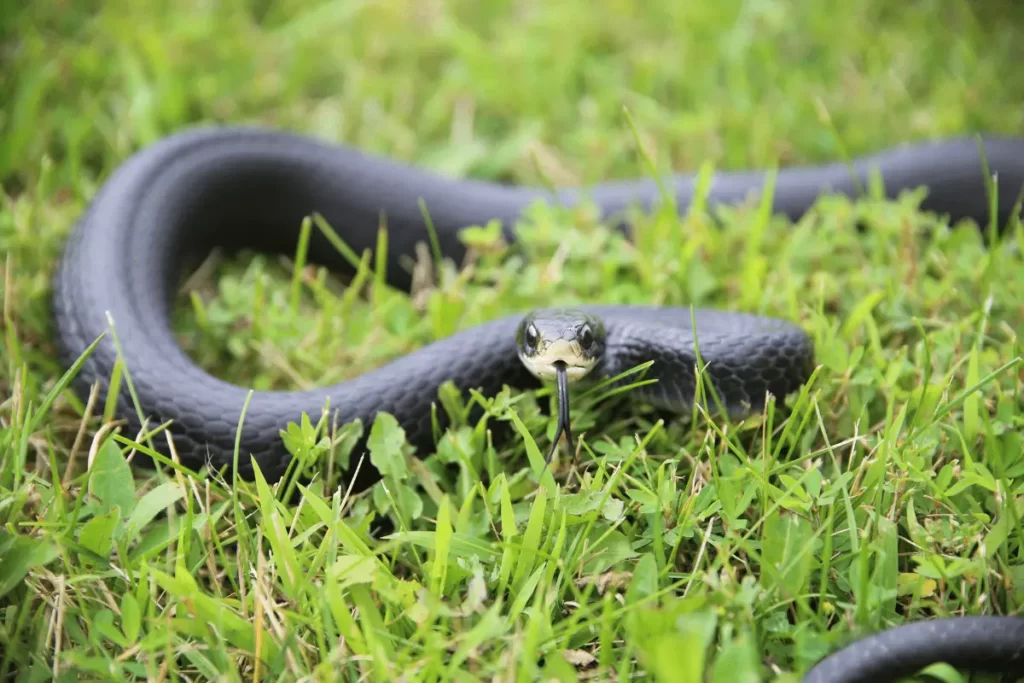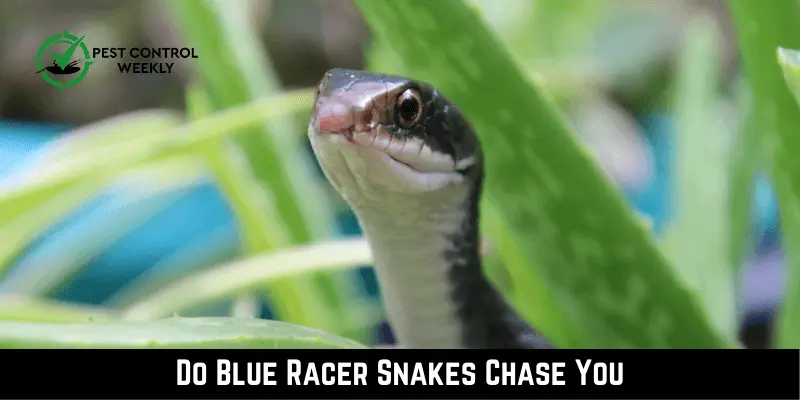Are you interested in learning more about the behavior of blue racer snakes, particularly regarding the age-old question: do blue racer snakes chase you?
No, Blue Racer doesn’t chase humans. It is a common misconception that Blue Racer snakes would chase humans. In general, Blue Racers are not aggressive and would rather avoid conflict. If they feel threatened, they may react defensively by hissing or striking, although this is more of a fear reflex than actual violence.
In this article, we will go into the world of blue racer snakes, investigate their traits, and discuss whether or not these snakes genuinely chase people.
What Are Blue Racer Snakes?
According to Ecology and Conservation of the endangered blue racer snake, Coluber constrictor foxii, on Pelee Island, Canada Blue Racer snakes (Coluber constrictor foxii) are sinuous Colubridae reptiles. These fascinating critters are mostly found in North America, especially in the eastern and central parts of the United States. Their attractive blue or blue-gray scales easily identify them.

One of the largest Colubrid species, these nimble snakes may reach up to 5 feet. They have keeled dorsal scales. Blue Racers use acute eyesight to hunt rodents, birds, and reptiles throughout the day. As predators, they can climb trees and swim well.
Blue Racer snakes constrict their prey and are nonvenomous. When threatened, they strike quickly and sweepingly. These snakes give birth to live young. Each litter produces 20 offspring in late June. These snakes are not endangered, but human development has destroyed their habitat. These fascinating reptiles and their native ecosystems need conservation efforts.
Blue Racer Snake Behavior
Diet and Hunting
Blue Racer snakes are known for their big appetites and varied diets. They eat a wide range of small critters. They eat rodents, birds, insects, amphibians, and reptiles. They have excellent eyesight, allowing them to easily identify prey during the day, and they rely on their agility and quickness to successfully grab their prey.
These agile reptiles seek, chase, and ambush victims. They can swim, climb trees, and navigate long grass for food. Blue Racers kill and eat their prey via constriction. Although nonvenomous, their swift and efficient hunting methods have made them formidable predators in their ecosystems.
Territoriality
Blue Racer snakes are territorial, especially during mating season. Males fight ritually to mate with receptive females. These shows usually entail tangling and grappling to establish control. Despite their apparent aggression, these interactions seldom cause major injury.
Blue Racers enjoy being alone outside the breeding season. They may blow up, hiss, and strike quickly when threatened. These snakes may chase imagined dangers, although this is usually a bluff to terrify. Remember that Blue Racer snakes, like other wild species, should be respected and watched safely. They hunt and survive in their native surroundings, yet they may defend themselves.
Blue Racer Snake Encounters
Unintentional Encounters
Humans may accidentally encounter Blue Racer snakes in nature. These shy serpents may defend themselves if threatened. Blue Racers hiss, inflate and attack quickly when threatened. Despite their non-venomous bites, these reptiles need room and respect.
There have been reports of Blue Racers chasing humans. This is unusual and usually, a bluff to deter threats. If a Blue Racer snake approaches you, stay calm, gently back away, and allow it to escape. Most conflicts can be addressed peacefully with patience and understanding.
Intentional Encounters
Blue Racer snakes are wild creatures and should be treated as such. If you intentionally bother a snake, it may react defensively, putting the animal under unnecessary stress and increasing the likelihood of a bite.
Be careful and keep your distance if you want to observe a Blue Racer snake in its natural environment. Use binoculars, telephoto lenses, or other devices to reduce noise and improve visibility. Remember that these snakes are crucial to their ecosystems and that our curiosity must not harm them.
Understanding Blue Racer snake behavior, respecting their limits, and recognizing their role in ecological balance is the key to harmonious cohabitation. Awareness and empathy can help us appreciate these extraordinary reptiles and their natural surroundings.
Do Blue Racer Snakes Chase People?
The Truth Behind The Myth
People often mistake the behavior of Blue Racer snakes and perpetuate the belief that they intentionally chase humans. In truth, the two most important things for these snakes are finding food and staying out of harm’s way. Hissing, puffing up, and striking are all protective responses they may display when threatened, but it’s important to remember that they’re not necessarily signs of hostility.
Blue Racers may occasionally chase people, although this is more of a show of strength than an actual threat. In such situations, it’s important to be cool, back away gently, and give the snake plenty of room to escape. The chances of having a bad encounter with them go far down if you give them their space and try to learn about their natural tendencies.
Factors Contributing To The Myth
Several factors contribute to the widespread belief that Blue Racer snakes will chase humans. The snake’s terrific speed and agility are major contributors; these characteristics might give the impression of aggressive pursuit when the snake is actually only trying to avoid danger.
Another thing that makes people afraid of snakes is the vivid tales and sensationalism that often go along with snake experiences. Misconceptions about snakes, sometimes fueled by exaggerated reports of encounters, abound because of the common belief that these reptiles are more deadly or aggressive than they are.
Misunderstanding snake behavior and its vital role in ecosystems can cause unfounded fears and misunderstandings. A more realistic and considerate perspective on Blue Racer snakes and their natural position may be fostered by debunking myths and gaining knowledge about these exciting species.
How to React to a Blue Racer Snake Encounter
Safety Tips
Follow these guidelines to ensure your safety and the safety of the Blue Racer snake if you ever come across one in the wild. To avoid any potential conflicts, please consider the following guidelines:
What To Do
- Keep a respectful distance so the snake doesn’t feel confined or frightened. We advise keeping at least six feet of distance.
- Avoid making any sudden movements or making loud noises, as this might shock the snake and cause it to react defensively. Maintain your composure and refrain from making any rash moves.
- If the snake seems angry or protective, step slowly back in the other direction to give it a chance to escape.
- Blue Racers are exciting creatures that play an important role in their ecosystems, so take the time to watch one and learn more about it. Admire them for who they are and what makes them special, but get out of their way.
- In order to refute myths and enhance awareness, please share your expertise about Blue Racer snakes and their behavior.
What Not To Do
Several things should be avoided when encountering a Blue Racer snake to keep both you and the snake safe:
- Avoid going too near the snake since doing so might make it feel frightened and prompt defensive actions.
- Don’t try to pet it; doing so might stress out the snake, which could lead to a bite. The snake should be seen from a safe distance out of respect for the snake’s independence.
- Please don’t put yourself in a compromising position. Cutting off the snake’s escape path might worsen an already bad situation.
- Blue Racer snakes are vital members of their ecosystems, and eliminating them would hurt the natural order. Instead, try to help people see and respect the incredible value of these reptiles.
- Don’t spread false information that Blue Racer snakes may chase people or become aggressive if aroused. The key to fostering peace between humans and these intriguing species is the free flow of factual information.
Protecting Blue Racer Snakes and Their Ecosystem
Conservation Efforts
Efforts to conserve the Blue Racer snake are essential for preserving biodiversity and ecological equilibrium. To assure their continued existence and success, many conservation efforts may be put into action:
- The long-term survival of snakes depends on our ability to preserve their natural habitats, which include grasslands, woods, and wetlands.
- Avoiding habitat loss due to urbanization, farming, and other human activities is important.
- Regular monitoring of Blue Racer snake populations might give useful data to guide conservation efforts and evaluate the efficacy of existing measures.
- Designating locations where these snakes are known to thrive as wildlife preserves or nature reserves can give them a place to live free from human influence, where they can reproduce, hunt, and develop without danger.
- Protecting the environments these snakes rely on requires promoting sustainable land use practices and careful stewardship of natural resources.
Educating the Public
The conservation of Blue Racer snakes relies heavily on public understanding of the species and its ecological significance. The importance of these reptiles to the ecology can be recognized and appreciated if more people take the time to learn about them.
- To reduce anxiety and promote a more realistic knowledge of Blue Racer snakes, it is important to debunk myths about them, such as the belief that they hunt humans.
- Promoting peaceful coexistence by reducing the chance of dangerous encounters and increasing knowledge on how to engage with these snakes safely and respectfully.
- Education on Blue Racer snakes and their ecosystems can help raise a new generation of ecologically aware individuals and help understand why preserving natural variety is crucial.
- Involving locals in conservation efforts, such as habitat restoration or citizen science programs, can help people feel more accountable for the survival of snakes like the western hognose and the ecosystems in which they live.
Final Thoughts
Blue Racer snakes are intriguing, environmentally important, and misunderstood. Although they may act defensively when threatened, these snakes are not aggressive and do not chase humans. We may gain a more realistic and respectful picture of these amazing reptiles by knowing their behavior, emphasizing safety, and conserving them.
Blue Racer snakes and their habitats depend on education and awareness. To ensure the long-term survival and well-being of these snakes and their habitats, dispelling misconceptions, fostering cohabitation, and encouraging community engagement are essential. We can create a more sustainable and peaceful future for all living things by protecting these unique species and their natural environment.
